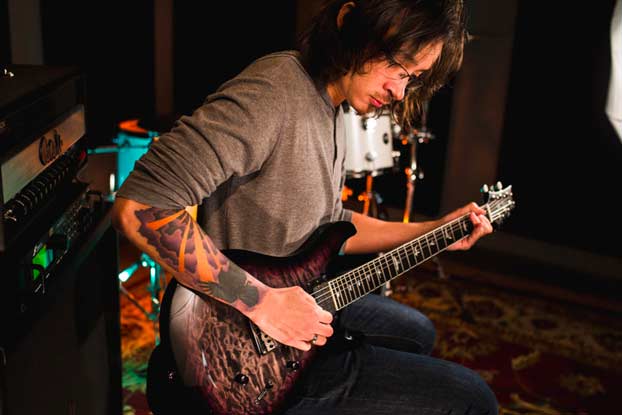Mastering the Sliding Techniques in Haunted Shores' “Blast Inc.”

A song that many fans have asked me about is “Blast Inc.,” which I recorded with my side project, Haunted Shores (check it out below).
We recorded this tune for the Viscera EP, and if you’re familiar with it, you know that it’s pretty intense! There are many fast, challenging licks in this song, all intended to be vapor-locked to its “blast beat” drum patterns.
Occasionally, one of my warm-up routines will find its way into a primary riff for a song, and that is the case with one of the sections in “Blast Inc.”
As I have demonstrated in many of the licks covered throughout these columns, I will often utilize dramatic position shifts up and down the fretboard in the execution of a specific lick or pattern, emphasized by the incorporation of legato techniques, such as hammer-ons, pull-offs and slides.
FIGURE 1 illustrates a lick played in this manner, which is performed on the G and A strings only. The notes on the G string are fretted with the index finger and the A-string notes are fretted with the middle finger. Each string is picked only once per bar, so all subsequent notes that follow the pick attack on the A string are sounded with either a slide, pull-off or hammer-on. Both licks are six-note patterns played in an eighth-note rhythm, so the lick is best notated in 3/4 meter.
I like to use licks like this one for warming up because it helps me to focus on sliding in and out of very specific positions on the fretboard, as accuracy with the sliding motion is essential for proper execution of the lick. It can be difficult to “nail” these shifts on the fly, so I tend to start slow and then speed up as I practice phrases like this.
Now let’s move on to the application of this technique in “Blast Inc.” For this song, my guitar is in “drop C” tuning, which is drop-D tuning down one whole step (low to high: C G C F A D). I think of the guitar in a “transposing” manner, meaning that I reference the chord and note names as if the guitar were tuned to drop-D at concert pitch. As shown in FIGURE 2, bars 1–3 feature rapid fretboard shifts between seventh and first position, with the technique detailed in FIGURE 1 employed in bars 2 and 3.
Bar 4 begins in ninth position and quickly shifts back to sixth position by the end of the bar. In bars 5–7, the lick is built from the movement of a fifth-string-root minor chord shape, starting with Dm in fifth position, which then slides down to a first-position Bbm and then up to C#m and F#m and then down to Fm. I additionally include the open high E string in each chord voicing, which lends a jarring dissonance to the progression while also serving to tie the tonality of the various chords together.
The sliding technique is revisited in bars 10 and 11, and the figure ends with similarly “displaced” minor chord voicings in bars 14–16. As always, work through each bar slowly and carefully, gradually increasing the tempo until you’re able to play the pattern up to the fast tempo of the recording.

Get The Pick Newsletter
All the latest guitar news, interviews, lessons, reviews, deals and more, direct to your inbox!









![Joe Bonamassa [left] wears a deep blue suit and polka-dotted shirt and plays his green refin Strat; the late Irish blues legend Rory Gallagher [right] screams and inflicts some punishment on his heavily worn number one Stratocaster.](https://cdn.mos.cms.futurecdn.net/cw28h7UBcTVfTLs7p7eiLe.jpg)
